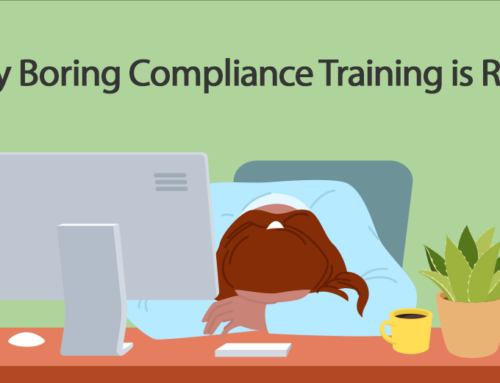Compliance Training – One Size Doesn’t Fit All
Why High-Risk Roles Need Deeper Compliance Training
Introduction
Not all jobs carry the same compliance risk. Yet many companies treat compliance training as a universal one-size-fits-all solution—one annual Code of Conduct course for everyone. While a broad baseline is critical for company-wide awareness, certain roles demand something more: deeper, more targeted training that addresses the real-world risks employees face in their day-to-day work.
In short? If everyone’s getting the same compliance training, someone’s probably not getting enough.
General Awareness Training: The Foundation
Every employee should know the basics—how to report a concern, the company’s ethics policies, and the big red flags. A concise, engaging Code of Conduct course is a great starting point, especially when refreshed annually.
But here’s the catch: the Code of Conduct often touches on many topics lightly — anti-bribery, insider trading, competition law, data privacy, and more — without going deep enough for roles that deal with those risks directly.
And let’s be clear: some topics require deeper training for every employee, regardless of role. For example:
- Data Privacy & GDPR: With increasing global data regulations, everyone needs to understand how to handle customer and employee data properly. As the International Association of Privacy Professionals (IAPP) notes, employee training is one of the most critical factors in avoiding privacy violations.
- Harassment & Respect in the Workplace: These aren’t just HR checkboxes — they’re foundational to a safe and productive workplace culture.
- Accurate Records and Financial Reporting: Everyone contributes to records — whether it’s time tracking, expense reporting, or customer communication.
- Insider Trading: For publicly traded companies, even casual employee conversations can have serious consequences.
These aren’t “nice-to-have“ trainings. They’re core expectations — and shallow overviews won’t cut it. Every employee should walk away with a clear understanding of their responsibilities in these areas and how to spot (and stop) potential issues.
Deep-Dive Training: The Risk-Based Layer
Some job roles require much more than general awareness. These “high-risk“ functions face situations where a bad decision isn’t just unethical — it could violate the law, damage your reputation, or cost your company millions.
Let’s look at a few examples:
- Sales teams working globally need more than a passing reference to anti-bribery rules. They need scenario-based training on interacting with foreign officials, giving gifts, and negotiating contracts in high-risk regions.
- Procurement professionals must understand conflict-of-interest policies, third-party due diligence, and how hospitality can cross a line.
- Accounts Receivable (AR) staff should be trained on money laundering red flags and suspicious transactions.
- Finance teams need deep familiarity with anti-corruption rules, insider trading, money laundering, and data privacy controls — not just in theory, but in practice.
These employees are on the front lines. Giving them “lite“ training is like sending a fire marshal into a blaze with a spray bottle.
Even the OECD’s Anti-Bribery Recommendation stresses that companies must provide enhanced training to individuals in higher-risk positions.
What Makes a Role “High Risk”?
Here are a few quick ways to identify high-risk job functions:
- They interact with third parties, especially vendors, contractors, or government entities.
- They handle money, contracts, or pricing.
- They work in regions or industries with elevated corruption or competition risk.
- They have discretionary decision-making power (e.g., approving spend, selecting 3rd party partners).
If a role checks two or more boxes, it’s ready for something more than a generic refresher.
What Does Deep-Dive Training Look Like?
It’s not just longer—it’s smarter:
- Realistic scenarios based on actual job tasks
- Microlearning modules that target specific risks (e.g., anti-corruption in vendor selection)
- Interactive decision-making to reinforce gray-area judgment calls
- Just-in-time training delivered during key workflows or approvals
At Xcelus, we often work with compliance officers to map out tiered training plans — giving every employee a strong ethical foundation and giving high-risk roles the tools they need to handle high-risk decisions.
Final Thoughts: Training Should Match the Risk
Compliance leaders know the risks aren’t spread evenly across the company. Your training strategy shouldn’t be either. A warehouse worker and a global sales exec don’t need the same playbook.
If you’re ready to move beyond checkbox compliance and toward risk-smart training, start by identifying the roles where mistakes matter most. Then, give those employees the skills, context, and confidence to do the right thing — even when it’s difficult.
Want help building a training plan that scales with your risk? We do that at Xcelus — and we’d love to help.
Remember Compliance Training – One Size Doesn’t Fit All
To see additional microlearning courses go to https://www.xcelus.com/limesmart/





